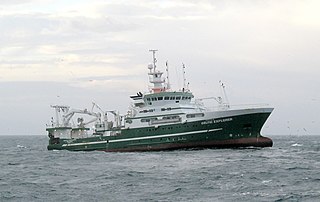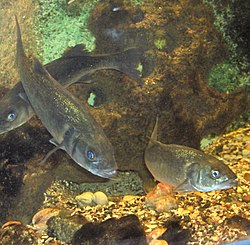
Fishing is the activity of trying to catch fish. Fish are often caught as wildlife from the natural environment, but may also be caught from stocked bodies of water such as ponds, canals, park wetlands and reservoirs. Fishing techniques include hand-gathering, spearing, netting, angling, shooting and trapping, as well as more destructive and often illegal techniques such as electrocution, blasting and poisoning.

Trawling is a method of fishing that involves pulling a fishing net through the water behind one or more boats. The net used for trawling is called a trawl. This principle requires netting bags which are towed through water to catch different species of fishes or sometimes targeted species. Trawls are often called towed gear or dragged gear.

Bycatch, in the fishing industry, is a fish or other marine species that is caught unintentionally while fishing for specific species or sizes of wildlife. Bycatch is either the wrong species, the wrong sex, or is undersized or juveniles of the target species. The term "bycatch" is also sometimes used for untargeted catch in other forms of animal harvesting or collecting. Non-marine species that are caught but regarded as generally "undesirable" are referred to as "rough fish" and "coarse fish".

A fishing trawler is a commercial fishing vessel designed to operate fishing trawls. Trawling is a method of fishing that involves actively dragging or pulling a trawl through the water behind one or more trawlers. Trawls are fishing nets that are pulled along the bottom of the sea or in midwater at a specified depth. A trawler may also operate two or more trawl nets simultaneously.

Gillnetting is a fishing method that uses gillnets: vertical panels of netting that hang from a line with regularly spaced floaters that hold the line on the surface of the water. The floats are sometimes called "corks" and the line with corks is generally referred to as a "cork line." The line along the bottom of the panels is generally weighted. Traditionally this line has been weighted with lead and may be referred to as "lead line." A gillnet is normally set in a straight line. Gillnets can be characterized by mesh size, as well as colour and type of filament from which they are made. Fish may be caught by gillnets in three ways:
- Wedged – held by the mesh around the body.
- Gilled – held by mesh slipping behind the opercula.
- Tangled – held by teeth, spines, maxillaries, or other protrusions without the body penetrating the mesh.

Bottom trawling is trawling along the seafloor. It is also referred to as "dragging". The scientific community divides bottom trawling into benthic trawling and demersal trawling. Benthic trawling is towing a net at the very bottom of the ocean and demersal trawling is towing a net just above the benthic zone. Bottom trawling can be contrasted with midwater trawling, where a net is towed higher in the water column. Midwater trawling catches pelagic fish such as anchovies and mackerel, whereas bottom trawling targets both bottom-living fish (groundfish) and semi-pelagic species such as cod, squid, shrimp, and rockfish.

Seine fishing is a method of fishing that employs a surrounding net, called a seine, that hangs vertically in the water with its bottom edge held down by weights and its top edge buoyed by floats. Seine nets can be deployed from the shore as a beach seine, or from a boat.

A turtle excluder device (TED) is a specialized device that allows a captured sea turtle to escape when caught in a fisherman's net.
The Scottish east coast fishery has been in existence for more than a thousand years, spanning the Viking Age right up to the present day.

Unsustainable fishing methods refers to the utilization of the various fishing methods in order to capture or harvest fish at a rate which sees the declining of fish populations over time. These methods are observed to facilitate the destructive fishing practices that destroy ecosystems within the ocean, and is used as a tool for over-fishing which results in the depletion of fish populations at a rate that cannot be sustained.

A fishing vessel is a boat or ship used to catch fish in the sea, or on a lake or river. Many different kinds of vessels are used in commercial, artisanal and recreational fishing.

A factory ship, also known as a fish processing vessel, is a large ocean-going vessel with extensive on-board facilities for processing and freezing caught fish or whales. Modern factory ships are automated and enlarged versions of the earlier whalers and their use for fishing has grown dramatically. Some factory ships are equipped to serve as a mother ship.

Fishing techniques are methods for catching fish. The term may also be applied to methods for catching other aquatic animals such as molluscs and edible marine invertebrates.

A fishing dredge, also known as a scallop dredge or oyster dredge, is a kind of dredge which is towed along the bottom of the sea by a fishing boat in order to collect a targeted edible bottom-dwelling species. The gear is used to fish for scallops, oysters and other species of clams, crabs, and sea cucumber. The dredge is then winched up into the boat and emptied. Dredges are also used in connection with the work of the naturalist in marine biology, notably on the Challenger Expedition.
This is a glossary of terms used in fisheries, fisheries management and fisheries science.

The coastline of the Russian Federation is the fourth longest in the world after the coastlines of Canada, Greenland, and Indonesia. The Russian fishing industry has an exclusive economic zone (EEZ) of 7.6 million km2 including access to twelve seas in three oceans, together with the landlocked Caspian Sea and more than two million rivers.

Mincarlo is the last surviving sidewinder fishing trawler of the Lowestoft fishing fleet. She is also the last surviving fishing vessel built in Lowestoft, with an engine made in the town.

Lift nets, also called lever nets, are a method of fishing using nets that are submerged to a certain depth and then lifted out of the water vertically. The nets can be flat or shaped like a bag, a rectangle, a pyramid, or a cone. Lift nets can be hand-operated, boat-operated, or shore-operated. They typically use bait or a light-source as a fish-attractor. Lift nets are also sometimes called "dip nets", though that term applies more accurately to hand nets.

Electric pulse fishing is a fishing technique sometimes used in trawl fisheries which produces a limited electric field above the seabed to catch fish. The pulse trawl gear consists of a number of electrodes, attached to the gear in the tow direction, that emit short electric pulses. The electrodes replace the tickler chains that are used in traditional beam trawl fishery. The pulse trawl fishery is mainly aimed at flatfish like sole, with by-catch plaice. In addition, the pulse trawl gear is applied in shrimp fisheries on a limited scale. Technically, the use of electricity to catch fish is prohibited in European waters. However, the European Union is able to provide exemptions to this rule since 2007. These exemptions are now mainly used by Dutch and British trawlers in the North Sea.
The South African Deep-Sea Trawling Industry Association (SADSTIA) represents the trawler owners and operators active in the offshore demersal trawl fishery for hake, the most valuable of South Africa's commercial fisheries, contributing approximately 45 percent of the value of fishery production. Based in Cape Town, South Africa, SADSTIA currently has 32 members that catch, process and market the Cape hakes, Merluccius paradoxus and Merluccius capensis as well as several bycatch species.



















